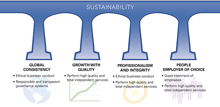
GLOBAL CONSISTENCY
Global Consistency is the pillar that integrates the network of member firms and
enables them to offer high-quality solutions and services, with access to experts
and centers of excellence which generate value for clients and give KPMG its
international reputation.
As highlighted, the KPMG International member firms are united by the same vision and same values. They also have the same global strategy, with common fundamental pillars and strategic objectives, which are put into practice through the local planning and governance structures.
Strategy Fundamentals at KPMG
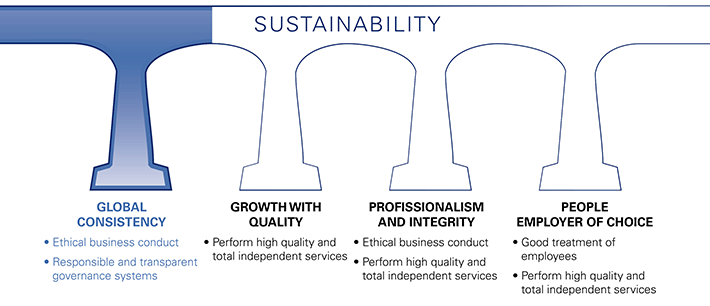
Corporate Governance
GRI 4.1We are one of the biggest organizations in the world in our sector and are entirely dependent on the ethical commitment of our professionals and member firms to maintain our reputation. For that reason, our structure is designed so that we conduct our business according to the highest standards of corporate governance, based on transparency and ethics.
Governance, then, is one of the cornerstones of our strategy, and its importance was validated in our recent stakeholder survey, in which it was ranked the second most important issue for a service provider like ourselves.
KPMG International establishes and coordinates norms and policies for the work and conduct at all of the countries, protecting and enhancing the use of its name and brand. This means ensuring global consistency of its strategy, in order to strengthen its name and promote services of the same quality to all of its clients and markets.
At the same time, each member firm is independent and responsible for its own management and the quality of its work and is committed to the values of KPMG International, and required, under contract, to comply with its policies and regulations, including the standards of quality that govern the way it operates and provides services to clients, in order to compete efficiently on the market.
See below a description of the governance tools and structures we have both locally and internationally.
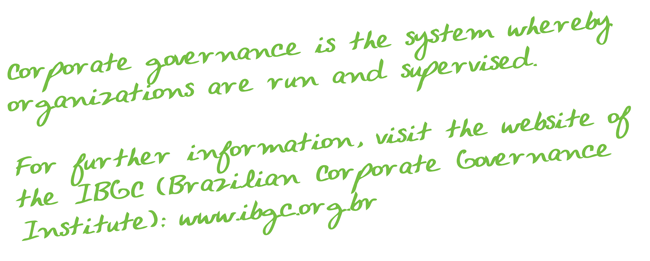
KPMG International Governance
The corporate governance structure at KPMG International is supported by four main bodies:
- The Global Council - this body focuses on strategy and governance, and performing functions equivalent to a shareholders’ meeting for a public stock corporation. Among other things, the Global Council elects the Chairman of KPMG International for a term of up to four years (renewable for a further four) and approves the appointment of the Global Board members, including representation from 55 member firms of KPMG International, in accordance with Swiss Law (sublicenses are generally indirectly represented by a member firm). Keep the forum active for discussions and communications between member firms.
- The Global Board - this is the principal governance and oversight body, and is responsible for including and approving strategies, protecting and enhancing the KPMG brand, overseeing management, and approving policies and regulations. It also admits member firms and ratifies the Chairman’s appointment of the members of the Global Executive Team.
- The Global Executive Team (GET) - this is the principal management body, and is responsible for implementing the strategy approved by the Global Board and for establishing processes to monitor and enforce policy compliance. It is led by the Chairman and includes global practice heads, regional leaders and senior partners of member firms.
- Global Steering Groups - supporting GET, these bodies are responsible for implementing the approved action plans to address the strategies determined for each of the specific business areas, for example, the Global People, Performance and Culture Group (PPC) and the Global Quality and Risk Management Group (GQRM).
This Board includes the Chairman of KPMG International, the vice Chairman, and the Chairman of each of the three regions, (the Americas; Asia Pacific – ASPAC; and Europe, the Middle East and Africa– EMA) and 20 senior partners from some of the largest member firms, including Brazil.
To support the global strategy, each one of the three regions in which KPMG operates — the Americas (North, Central and South America), EMA (Europe, the Middle East and Africa) and Aspac (Asia and Pacific) — is administered by a Regional Board that assists in the implementation of policies and regulations focusing specifically on the needs of the member firms within their regions. David Bunce, a partner of KPMG in Brazil, is a member of the Regional Board for the Americas, as the Chairman for South America.

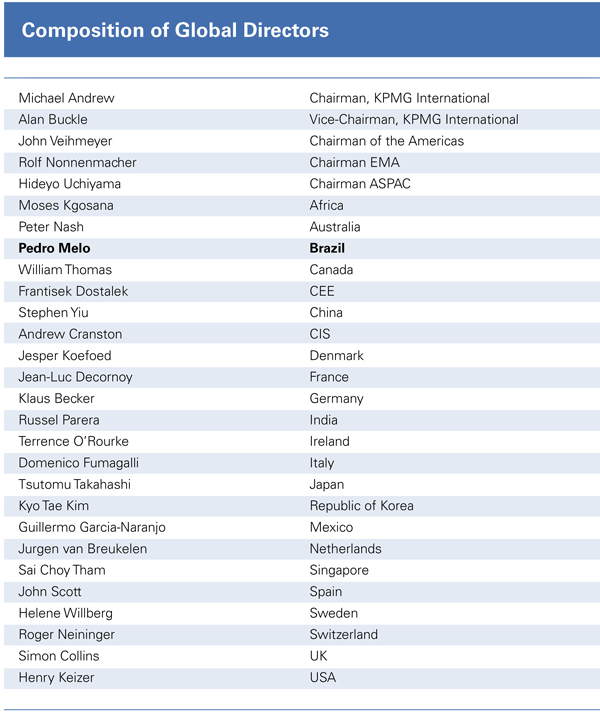
KPMG in Brazil Governance
GRI 4.9As mentioned, each KPMG member firm is responsible for its own management and the quality of its services, and is contractually responsible for maintaining global consistency in the presentation and offering of its services.
The local structures for corporate governance also adhere to global standards. KPMG in Brazil has its own governance bodies for coordinating and supervising its management, structured in accordance with Brazilian laws.
As part of the career development process, our best professionals become partners within the Organization, and provided they fulfill certain criteria, can be nominated for Chairman.
The Chairman of KPMG in Brazil is the principal local executive and is elected by the other partners for a term of three years, renewal for a further two mandates of the same period. With this limitation, we promote changes in command and encourage various partners to join senior management, maintaining our succession process.GRI 4.2

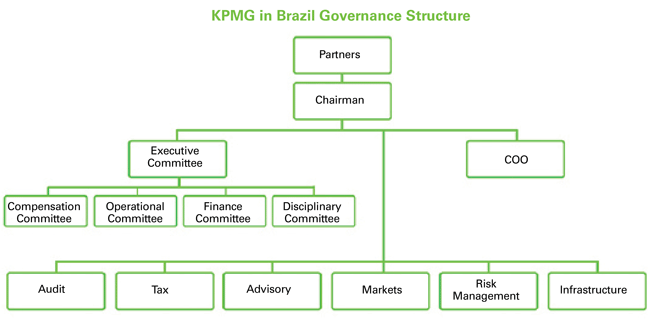
The Chairman is responsible for nominating the Executive Committee, which comprises the Chairman and seven other partners, usually heads of the main business practices, so that all of them are represented. The administrative area, which includes the Corporate Citizenship area, is represented by the COO.
In Brazil, sustainability performance is assessed in two spheres by the Corporate Citizenship area, which answers directly to the Chief Operating Officer - COO:
Strategic Sphere:: accompany goals and policies adopted globally and locally.
Operational Sphere: presentation of annual action plan and projects to the COO, the Chairman and Executive Committee, and also reporting in quarterly meetings and presentation of actions in progress to the COO.
In addition, members of the Executive Committee are involved in the initial interviews for preparing our sustainability report, and also in reviewing it, which is when our results are presented in a more systematic manner.
Together, the Chairman and the Executive Committee are responsible for the policy, planning, supervision and general management of activities, including defining goals for local growth and determining the strategic management of the business areas, ensuring consistency with global strategy.
As leaders of their business practices, the members of the Executive Committee continue to exercise their responsibilities in rendering services to clients. Since it consists of partners who undertake their professional activities, the Executive Committee does not include any independent members.GRI 4.3
This organizational structure favors a dialogue between the leaders and the other partners and professionals, ensuring that the needs of the areas are represented at the Committee, which meets monthly. GRI 4.4
Furthermore, we hold quarterly meetings with all of the partners who present their results and strategic alignment and we hold annual statutory meetings with all of the partners to approve the accounts, amongst other issues.
To obtain access to guidance and recommendations from our professionals, we promote dialogue through mechanisms such as periodic meetings by business group, Dialogue, Global People Survey, PPL Committee, Disciplinary Committee, Hotline and social media like The Chairman’s Blog and The KPMG World — and from which initiatives were suggested, such as: the creation of a Women’s Committee, the environmental targets and review of the policy for language allowances, the competition to create a theme for the trainee program, internal campaigns for recruitment of persons with disabilities (PCDs) and the program to improve internal communication.GRI 4.4
Our structure has an Operational Committee, consisting of leaders from the operational areas and the leader from the Markets area, which determines the undertaking of routine business, considering achieving the goals established in the strategic plan, with the Finance Committee, which handles the investments of the Organization, and also with the Compensation Committee, which deals with the rules for remunerating partners and partners-directors.
Another essential body for our governance structure is the Disciplinary Committee, presented in the chapter on Professionalism and Integrity, which analyzes possible violations of rules and policies by any of our professionals, including partners. This committee comprises leaders from the operational areas, the Director of People, Performance and Culture, the partner responsible for Risk Management and the ChairmanGRI 4.6
All of the governance practices, based on standards adopted globally, strengthen our brand and reputation and assist in maintaining the standards of quality for which we want to be recognized in all of the markets we serve.
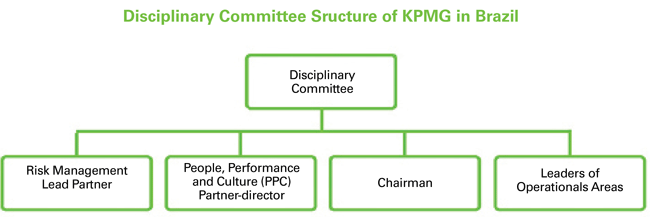
© 2013 KPMG Auditores Independentes, a Brazilian entity and a member firm of the KPMG network of independent member firms affiliated with KPMG International Cooperative (“KPMG International”), a Swiss entity. All rights reserved.
KPMG International Cooperative ("KPMG International") is a Swiss entity. Member firms of the KPMG network of independent firms are affiliated with KPMG International. KPMG International provides no client services. No member firm has any authority to obligate or bind KPMG International or any other member firm vis-à-vis third parties, nor does KPMG International have any such authority to obligate or bind any member firm.
